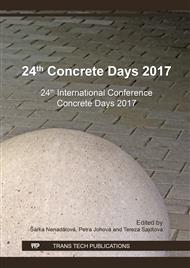[1]
ČSN ISO 1920-10 Zkoušení betonu - Část 10: Stanovení statického modulu pružnosti v tlaku. ÚNMZ, Praha, (2016).
Google Scholar
[2]
ČSN EN 12390-13 Zkoušení ztvrdlého betonu - Část 13: Stanovení sečnového modulu pružnosti v tlaku, ÚNMZ, Praha, (2014).
Google Scholar
[3]
ČSN 73 6174 Stanovení modulu pružnosti a přetvárnosti betonu ze zkoušky v tahu ohybem, ČNI, Praha, (1994).
Google Scholar
[4]
ČSN 73 1371 Nedestruktivní zkoušení betonu – Ultrazvuková impulzová metoda zkoušení betonu, ÚNMZ, Praha, (2011).
DOI: 10.51704/cjce.2016.vol2.iss1.pp76-82
Google Scholar
[5]
ČSN 73 1372 Nedestruktivní zkoušení betonu – Rezonanční metoda zkoušení betonu, ÚNMZ, Praha, (2012).
DOI: 10.51704/cjce.2016.vol2.iss1.pp76-82
Google Scholar
[6]
P. Cikrle, Význam nedestruktivních diagnostických metod pro hodnocení železobetonových konstrukcí, Brno, 2016, 174 s, Habilitation Thesis.
Google Scholar
[7]
V. M. Malhorta, N. J. Carino, Handbook on nondestructive testing of concrete, 2nd ed., Boca Raton, CRC Press, (2004).
Google Scholar
[8]
ČSN EN 12504-4 Zkoušení betonu – Část 4: Stanovení rychlosti šíření ultrazvukového impulsu. ČNI, Praha, (2005).
Google Scholar
[9]
Ultrasonic imaging scanner: Pundit 250 Array [online], [cit. 2017-03-03], available at: https://www.proceq.com/product/pundit-250-array-ultrasonic-imaging-scanner.
Google Scholar
[10]
P. Cikrle, O. Anton, P. Daněk, B. Kucharczyková, P. Misák, T. Grohová, NDT zkoušení ve stavebnictví, Brno, 2015, CPD course guide.
Google Scholar
[11]
O. Buyukozturk, Nondestructive testing of materials and structures, Dordrecht, Springer, (2013).
Google Scholar
[12]
B. Kopec et al, Nedestruktivní zkoušení materiálů a konstrukcí, CERM, Brno, (2008).
Google Scholar
[13]
D. Kocáb, M. Králíková, P. Cikrle, P. Misák, B. Kucharczyková, Experimental analysis of the influence of concrete curing on the development of its elastic modulus over time, Mater. Technol. 51 (2017) 4, pp.657-665.
DOI: 10.17222/mit.2016.248
Google Scholar
[14]
A. M. Neville, Properties of concrete, 5th ed., New York, Pearson, (2011).
Google Scholar
[15]
ČSN 73 2011 Nedestruktivní zkoušení betonových konstrukcí. ÚNMZ, Praha, (2012).
Google Scholar
[16]
ČSN EN 1992-1- 1 Eurokód 2: Navrhování betonových konstrukcí – Část 1-1: Obecná pravidla a pravidla pro pozemní stavby. ÚNMZ, Praha, (2011).
Google Scholar
[17]
P. Cikrle, D. Kocáb, Dynamické a statické moduly pružnosti betonu, TZB-info, Brno, (2014).
Google Scholar


